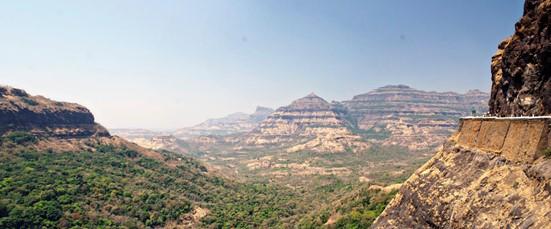
India’s Deccan Traps is an active volcano site that has been tied to End-Cretaceous mass extinction some 66 million years ago. New research is helping to determine whether it played a significant role. (Photo credit: Loÿc Vanderkluysen - Drexel University)
There have been five mass extinctions during the last 500 million years of Earth’s history. The most recent, the End-Cretaceous extinction event, or Cretaceous-Paleogene Boundary, occurred approximately 66 million years ago. It is most commonly associated with the disappearance of the dinosaurs. Numerous other land- and sea- dwelling species disappeared as well. Voluminous volcanism in the Deccan Traps in India occurred at the same time as the Chicxulub asteroid impact, and the contributions of both impact and volcanism to changes in climate around the time of the mass extinction have long been debated.
Now, a team including researchers from CUNY, UC Berkeley, Drexel University, Virginia Tech, and Cambridge University have unraveled a key part of this story. A period of sharply warmer global temperatures preceded the extinction event, and is thought to have been caused by release of the greenhouse gas carbon dioxide Deccan volcanism. One challenge is that there have been few good estimates of the amount of carbon released by volcanic eruptions, and the existing estimates suggest that volcanic activity did not supply enough carbon dioxide to explain the magnitude of the temperature increase.
To arrive at better estimates of carbon dioxide release from Deccan volcanism, the study’s lead author Andres Hernandez Nava, a CUNY Ph.D. student mentored by Benjamin Black, assistant professor in The City College of New York’s Division of Science, analyzed tiny droplets of frozen magma known as melt inclusions trapped inside olivine crystals in erupted lavas. These trapped droplets act like time capsules, recording the properties of 66 million year old magmas. There is a wrinkle, however: even these time capsules may have lost some carbon dioxide before they formed. To account for the initial carbon dioxide in the magma, they also used other elements that track carbon dioxide when the Earth’s mantle undergoes melting.
Hernandez-Nava, Black and their collaborators, developed a new and improved record of carbon dioxide release during the opening phases of Deccan volcanism—but they also found that some carbon dioxide seemed to be missing to complete the link between volcanic activity and the independently observed changes in Earth’s climate 66 million years ago.
Click here to read the study in the journal “PNAS Proceedings of the National Academy of Sciences.”
About the City College of New York
Since 1847, The City College of New York has provided a high-quality and affordable education to generations of New Yorkers in a wide variety of disciplines. CCNY embraces its position at the forefront of social change. It is ranked #1 by the Harvard-based Opportunity Insights out of 369 selective public colleges in the United States on the overall mobility index. This measure reflects both access and outcomes, representing the likelihood that a student at CCNY can move up two or more income quintiles. In addition, the Center for World University Rankings places CCNY in the top 1.8% of universities worldwide in terms of academic excellence. Labor analytics firm Emsi puts at $1.9 billion CCNY’s annual economic impact on the regional economy (5 boroughs and 5 adjacent counties) and quantifies the “for dollar” return on investment to students, taxpayers and society. At City College, more than 16,000 students pursue undergraduate and graduate degrees in eight schools and divisions, driven by significant funded research, creativity and scholarship. CCNY is as diverse, dynamic and visionary as New York City itself. View CCNY Media Kit.
Erica Rex
p: 845 668 0322
e:
erex@ccny.cuny.edu
View CCNY Media Kit.